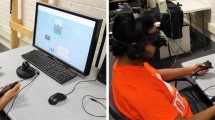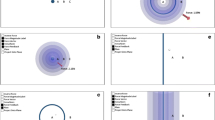Abstract
It is thought that anyone can get high learning effect anywhere by VR learning with tablet device. In this study, we focused on the field of thermodynamics having difficulties in understanding the basic logical structure for high school students. The purpose is to assist understanding of thermodynamic principles by simulating and visualizing the invisible phenomena with VR. We developed a system for controlling the temperature of a pen type thermal sensation presentation device and implemented it on SPIDAR-tablet using iPad. And we constructed an experimental simulation content of thermodynamics with a piston and a cylinder. It presents the pressure and the temperature of the gas in the cylinder as the force and the thermal sensation respectively. Then, we conducted an experiment to investigate the effects of presenting the sensations on adiabatic change simulation of thermodynamics. Many participants felt easier to imagine the principle of it when presenting both the force and the thermal sensation than when presenting only the force sensation. Therefore, it is considered that the understanding of the principle was improved by presenting the thermal sense. However, there were many opinions that they could not feel the enough change in the force.
Access provided by Autonomous University of Puebla. Download conference paper PDF
Similar content being viewed by others
Keywords
1 Introduction
1.1 Background and Purpose
In recent years, educational methods using information and communication technologies such as personal computers, tablet device and the Internet have become widespread. Furthermore, learning support systems using VR have been developed. By using VR, it is expected that it will become possible to experience phenomena that cannot be realized originally, that high learning effects will be obtained in VR space, and that learners will be able to participate independently. Therefore, we thought that anyone could get high learning effects everywhere by incorporating VR technology using tablet device into the learning. In this study, we developed a learning support system for thermodynamics, where it is difficult to understand the basic logical structure. The purpose is to develop a tablet device with visual, force and thermal sensations and to assist understanding of thermodynamic principles by presenting invisible phenomena using the device.
1.2 Outline of Research
We developed and implemented a pen type thermal sensation presentation device on SPIDAR-tablet [1] using iPad [2]. We developed a novel tablet device with function that can present the force and the thermal sensation simultaneously and evaluated it using thermodynamics learning system originally developed.
2 Proposed Device
2.1 SPIDAR-Tablet
SPIDAR-tablet is a haptic device that can present force sense to user’s fingertip during touch panel operation of a tablet device. Four strings are connected to a ring, and the tensions of the strings are controlled by motors attached to the corners on the tablet device. The force can be presented on the finger via the ring. In this paper, we employed the SPIDAR-tablet for iPad shown in Fig. 1.
2.2 Pen-Type Thermal Sensation Presentation Device
As the device for adding the thermal sensation on the SPIDAR-tablet, we developed a pen-type thermal sensation presentation device shown in Fig. 2. This device has a heat sink with fan inside a frame made by a 3D printer and has four small Peltier elements with copper plates on the grip to enable presenting thermal sensations at two fingertips.
2.3 Temperature Control Circuit
We constructed a control circuit to control the temperature of the pen-type thermal sensation presentation device. Figure 3 shows the circuit diagram. The CPU is PIC24FJ64GB004 (Microchip Technology Inc.) and the motor driver is BD6212HFP (ROHM Co., Ltd.) for controlling the Peltier elements.
Software Configuration.
Figure 4 shows the system configuration of the temperature control. The target temperature is set according the simulation on the tablet device. And the target temperature is sent to CPU by BLE communication. The CPU compares the target temperature with the temperature of the Peltier element and determines the PWM duty ratio by PID control.
2.4 Evaluation of Temperature Presentation
Copper plates are placed on Peltier elements and the temperature is transmitted from Peltier elements to copper plates, and when the user holds the pen at the copper plates, the temperature is presented. There is a temperature sensor between Peltier elements and copper plates. We used PWM control to control the temperature, and its duty ratio was determined by PID control. Figure 5 shows the measurement results of the temperature sensor when the temperature of Peltier elements was set to change from 24 °C to 40 °C. By optimizing the PID coefficient, we shortened the response time and reduced the ripple at around 40 °C.
3 Evaluation Experiment
3.1 Developed Application
In this research, we realized a thermodynamic experiment using a piston and a cylinder in a virtual space using a SPIDAR tablet with a pen-type thermal sensation presentation device. We developed virtual space using Unity 3D [2] which is one of the developing environments for 3D programs. Figure 6 shows an example of the developed virtual space.
In this application, the devices present the pressure and the temperature of the gas in the cylinder as the force and the thermal sensation respectively, and the movement and temperature change of particles inside present visually. When the learner moves the piston by touch operation, the velocity of the particles and the indicate value of the thermometer change according to the selected one of four state changes of the thermodynamics.
3.2 Experimental Method
We conducted an experiment to investigate the effects of presenting the thermal sensation on adiabatic change simulation of thermodynamics. In this experiment, the number of participants was 20. Figure 7 shows the visual presentation of the tablet device, and Fig. 8 shows the experimental environment. First, we lectured the principle of the adiabatic change used in the experimental simulation to the participants. Next, we explained the experimental procedure as follows. The position 1 in Fig. 7 is the initial position of the piston, the position 2 is the start position for the operation, and the position 3 is the maximum compressed position. The participants operated according to the following instructions from (1) to (6).
-
(1)
Touch the piston located at the position 1 with the pen and wait for a signal (until the temperature stabilizes at 33 °C).
-
(2)
Move the piston to the position 2 and wait 10 s.
-
(3)
Move the piston to the position 3 for 10 s.
-
(4)
Move the piston to the position 2 from 3 for 10 s.
-
(5)
Wait 10 s at the position 2.
-
(6)
Move the piston to the position 1 and wait for a signal (until the temperature stabilizes at 33 °C)
Preliminary Operation Task for Training (Task 1).
The participants were allowed to move the piston freely for 30 s. During this task, only the pressure of the gas in the cylinder was presented as the force sensation.
Operation task with the force and thermal sensation (Task 2).
The research participants operated according to the instructions (1)–(6). During this task, the pressure and the temperature of the gas in the cylinder as the force and the thermal sensation respectively.
Questionnaires.
Afterwards, they were asked to answer the questionnaires and state their opinions on this task. Table 1 shows the questionnaires for Task 1, Table 2 shows the questionnaires for Task 2, and Table 3 shows the options for the questionnaires.
3.3 Experimental Results and Discussions
Table 4 shows the average score of the questionnaire. Table 5 shows specific opinions. It is difficult to evaluate the difference between two tasks due to the difference of the experimental condition, however, in question (1) and (2) in Table 4, all scores were above 3 and the score of Task 2 was higher than that of Task 1 in question (1). This system has been shown to be effective in imagining the principle of adiabatic change, and that the presentation of thermal sensations is more effective. Next, in question (3) in Table 4, the score was 3.85, which was lower than the other scores. This is probably because the force feeling was smaller than the thermal feeling, as the opinion 1 and 2 in Table 5. It seems that it is necessary to change the motors to more powerful ones. Also, from Table 5, it can be seen that many participants found the learning content fun and interesting. This is thought to lead to an improvement in learning motivation.
4 Conclusions and Future Work
In this research, we developed a temperature control system for a pen-type thermal sensation presentation device and added it to SPIDAR-tablet for iOS. And we developed a device that can present simultaneously the force and the thermal sensations. Also, we evaluated this system using thermodynamic learning content originally developed. As a result, the presentation of both the force sensation and the thermal sensation helps learners to understand the principles of thermodynamics. However, many participants felt that it was difficult to feel changes in the force and thermal sensation simultaneously and they could not feel the enough change in the force. It is considered that the intensity of the force sensation was too small. Therefore, it seems that it is necessary to change the motors to more powerful ones. In addition, we plan to design and construct a small circuit board and implement on the frame. Also, we aim at developing new applications for this system.
References
Tasaka, Y., Yamada, K., Kubo, Y., Saeki, M., Yamamoto, S., Yamaguchi, T., Sato, M., Harada, T.: Development of frame for SPIDAR tablet on windows and evaluation of system-presented geographical information. In: Yamamoto, S., Mori, H. (eds.) HIMI 2018. LNCS, vol. 10904, pp. 358–368. Springer, Cham (2018). https://doi.org/10.1007/978-3-319-92043-6_30
Apple Inc. https://www.apple.com/ipad/. Accessed 12 June 2020
Unity Technologies. https://unity.com. Accessed 12 June 2020
Acknowledgments
We would like to thank all the research participants. This work was supported by JSPS KAKENHI Grant Number JP17H01782.
Author information
Authors and Affiliations
Corresponding author
Editor information
Editors and Affiliations
Rights and permissions
Copyright information
© 2020 Springer Nature Switzerland AG
About this paper
Cite this paper
Nohara, K., Kubo, Y., Sato, M., Yamaguchi, T., Harada, T. (2020). Development and Evaluation of a Pen Type Thermal Sensation Presentation Device for SPIDAR-Tablet. In: Stephanidis, C., Kurosu, M., Degen, H., Reinerman-Jones, L. (eds) HCI International 2020 - Late Breaking Papers: Multimodality and Intelligence. HCII 2020. Lecture Notes in Computer Science(), vol 12424. Springer, Cham. https://doi.org/10.1007/978-3-030-60117-1_17
Download citation
DOI: https://doi.org/10.1007/978-3-030-60117-1_17
Published:
Publisher Name: Springer, Cham
Print ISBN: 978-3-030-60116-4
Online ISBN: 978-3-030-60117-1
eBook Packages: Computer ScienceComputer Science (R0)












